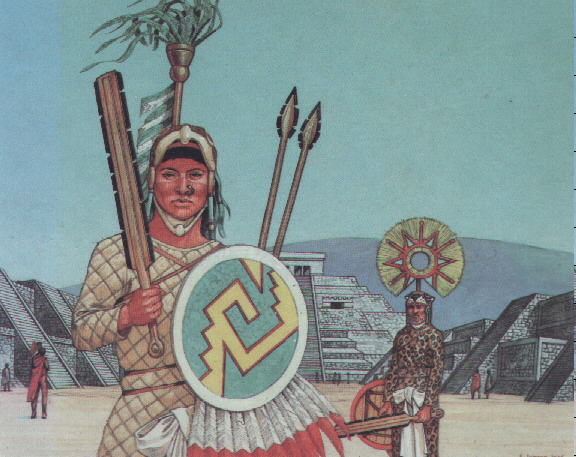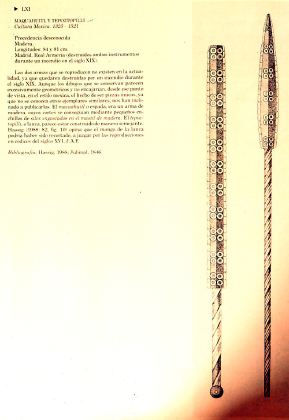Here are some pictures I found from a reconstruction, although the blades are a little crude compared to the original. The site also shows a set of aztec weapons with a macquahuitl and a halberd like spear. They seem to be the last original examples and show really great workmanship. Another, but only slightly larger picture can be found when you search for 'macquahuitl' at google.
So take a look at this site: [color=darkred]www.allempires.com/Forum/forum_posts.asp?TID=1955&PN=1[/color]
Sorry for somehow spoiling the link. :surprised:
One more try:
www.allempires.co/Forum/forum_posts.asp?TID=1955&PN=1
One more try:
www.allempires.co/Forum/forum_posts.asp?TID=1955&PN=1
Felix,
Thank you very much for these wonderful pictures. I really appreciate it.
Kind regards
Manouchehr
Thank you very much for these wonderful pictures. I really appreciate it.
Kind regards
Manouchehr
| Manouchehr M. wrote: | ||
Hi Dan, Where can I buy this article? Thanks a lot for your input. Kind regards Manouchehr |
Maney Publishing.
www.maney.co.uk
Arms & Armour is the new title of the Royal Armouries journal.
| Quote: |
| He comprehensively debunks the myth that the weapon could sever a horse's head. |
I'd have to read it, but I'm very dubious. I'll take period accounts over modern tests any day of the week, especially considering that a steel sword could easily behead a horse.
You haven't read that period source have you? There is no "eye-witness" account as many people claim.
The actual translation (emphasis mine) reads as:
He is repeating nothing but hyperbole told to him by a native who was intimidated by Spanish horses and pretending that he had no need for a steel sword.
The actual translation (emphasis mine) reads as:
| Quote: |
| ... and this weapon was so fierce that they claimed that with one stroke they could chop off a horse's head... |
He is repeating nothing but hyperbole told to him by a native who was intimidated by Spanish horses and pretending that he had no need for a steel sword.
| Jean Thibodeau wrote: |
| How about using the same ceramic that Boker uses to make ceramic blade folding knives: I think it's more fragile that steel but less brittle than glass ? Would also be able to take a super edge. And maybe extra blades could be supplied with it or offered later as replacements. |
As I recall the making of ceramic blades is very expensive with kitchen knives running into the $100's. i just think that this would be cost prohibitive. Cool Idea though, maybe you could contact them and ask for broken pieces to use?
| Quote: |
| You haven't read that period source have you? There is no "eye-witness" account as many people claim. |
Actually, there is. It comes from Bernal Díaz del Castillo. Here's A. P. Maudslay's English translation of what he wrote:
| Quote: |
| Pedro de Moron, was a very good horseman, and as he charged with three other horsemen into the ranks of the enemy the Indians seized hold of his lance and he was not able to drag it away, and others gave him cuts with their broadswords, and wounded him badly, and then they slashed at the mare, and cut her head off at the neck so that it hung by the skin, and she fell dead. |
And in Spanish:
| Quote: |
| Y lo pusieron por obra arremetiendo, y echan mano a una muy buena yegua y bien revuelta de juego y de carrera, y el caballero que en ella iba, buen jinete, que se decía Pedro de Marón, y como entró rompiendo con otros tres de a caballo entre los escuadrones de los contrarios, porque así les era mandado, porque se ayudasen unos a otros, échanle mano de la lanza, que no la pudo sacar, y otros le dan de cuchilladas con los montantes, y le hirieron malamente; y entonces dieron una cuchillada a la yegua que le cortaron el pescuezo redondo y colgado del pellejo: y allí quedó muerta. |
http://www.antorcha.net/biblioteca_virtual/hi...al/27.html
Note that a "montante" is a two-handed sword, so this makes the account even more believable.
ah got it. I had a different source. Obregon's experiment seems to suggest that any strike that meets with bone will destroy the edges making it useless afterwards, but the first strike may sometimes cut through bone. He only used a one-handed variant. Not the two-handed type.
There is some period documentation supporting this.
"... they can split a man in two with a single blow, provided this is the first one, since all further blows are useless, such is the sharpness of this weapon and its fragility."
Hernandez de Cordova, Historia natural de Nueva Espana p407
There is some period documentation supporting this.
"... they can split a man in two with a single blow, provided this is the first one, since all further blows are useless, such is the sharpness of this weapon and its fragility."
Hernandez de Cordova, Historia natural de Nueva Espana p407
It seems to me that there is a slot around the weapon to hold in the obsidian blades. Is it possible that this would allow damaged sections to be replaced as needed?
| Alex Oster wrote: |
| As I recall the making of ceramic blades is very expensive with kitchen knives running into the $100's. i just think that this would be cost prohibitive. Cool Idea though, maybe you could contact them and ask for broken pieces to use? |
Sorry to be somewhat off topic:
Indeed, a company named Kyocera has a rather extensive line of excellent ceramic kitchen knives. They are not always that expensive - a paring knife goes for about $35, I think. However, one of their top quality yanagi ba is near $300, if I remember correctly. That's not all that expensive, considering there are some yanagi ba of mirror polished Ao-Ko steel that run for a couple thousand, but that's the way with anything, I suppose - there's always an extreme.
I'm not sure this material would really be worthwhile as a substitute, though. While it is more obsidian-like than steel, it's nature is considerably more durable. While it may chip and crack, I doubt there would be the same sort of fracture seen on a relatively thin sheet of obsidian (comparing only to making/using obsidian arrow heads, my only experience with obsidian). I wonder if there is any sort of 'super-glass' that approaches the properties of obsidian more closely?
| Quote: |
| Knowing soldiers, the basis of the horse decapitation story is probably something along the lines of:
"Hey, Josse! Did you see what that aztec b*stard did to my horse!? nearly took his head right of! D*mn sure hope it recovers, 's a d*mn fine horse..." |
I guess he would say:
¨!Hey José! ¿Has visto lo que aquel b*stardo Azteca hijo de p*ta le acaba de hacer a mi caballo? !Casi le cercena la cabeza! M*ldición, espero que se recupere, es un m*ldito buen caballo...
Seriously, despite having so sharp weapons, Aztecs, as someone previously said before me, prefered to take prisoners for sacrifices instead of killing them, obviously Floral Wars are not the same that fighting Conquerors, but i guess that they would still try to capture them.
Can´t Macahuitl be used as maces after edges were broken?
Anyway, does somebody know were can i find Aztec/ Jaguar warrior´s armours?
Thanks.
| Rodolfo Martínez wrote: |
|
Anyway, does somebody know were can i find Aztec/ Jaguar warrior´s armours? Thanks. |
Rodolfo;
I'm thinking that putting together a Jaguar Knight's kit would have to be pretty much a "Do-it yourself" project, as I don't know of anyone, anywhere making anything even remotely like the proper padded garmets you would need, not to mention the jaguar skin outer layer (which unless you use fake fur, would probably get you in lots of trouble in most countries anyway!).
That being said, a kit like that would have to count as being one of the coolest ever to be seen anywhere... :D
Cheers!
Gordon
| Benjamin H. Abbott wrote: | ||||||
Actually, there is. It comes from Bernal Díaz del Castillo. Here's A. P. Maudslay's English translation of what he wrote:
And in Spanish:
http://www.antorcha.net/biblioteca_virtual/hi...al/27.html Note that a "montante" is a two-handed sword, so this makes the account even more believable. |
Sorry for reviving this thread, but I felt compelled to step in a squash this myth.
The evidence is in the quote:
| Quote: |
| and then they slashed at the mare |
If more than one person slashed at the mare, then clearly the horse was not killed with a single stroke. Now unless the Spanish says, the head was cut off with a single stroke then there is no reason to believe that it happened. The English translation paints a picture of several warriors hewing into the animal and its rider, then cutting the head off of the mare, sounds more like butchering the animal than a clean cut.
Cheers!
Page 3 of 3
You cannot post new topics in this forumYou cannot reply to topics in this forum
You cannot edit your posts in this forum
You cannot delete your posts in this forum
You cannot vote in polls in this forum
You cannot attach files in this forum
You can download files in this forum
All contents © Copyright 2003-2006 myArmoury.com — All rights reserved
Discussion forums powered by phpBB © The phpBB Group
Switch to the Full-featured Version of the forum
Discussion forums powered by phpBB © The phpBB Group
Switch to the Full-featured Version of the forum

